My Cat Is Vibrating Their Tail

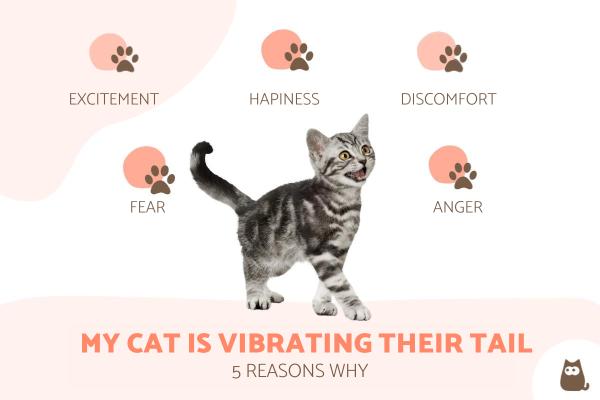

See files for Cats
You may have seen a cat shake its tail like a rattlesnake. Pointed perpendicular to the ground, the hairs stand on end and it vibrates in a pulsing rhythm. Tail movement is an important part of cat communication, using it to signal to others in their environment their emotional state. This body language can be subtle and each signal needs to be understood in context. As guardians, it is vital that we pay attention to our own cat and get to know their personal body language. This is the best way to understand their needs so that we may respond to them appropriately. It will improve the well-being of the cat as well as the bond you share together.
At AnimalWised, we look at why my cat is vibrating their tail. We explore the reasons cats shake their tail and how we can use this understanding to ensure their health and well-being.
Excitement
Some of us may think that a cat vibrating their tail signals a negative emotion, but this is not necessarily the case. Moreover, a cat shaking their tail is most often a positive sign. It shows a level of heightened excitement and happiness, often in anticipation of a positive stimulus.
One of the most common situations where we see a cat vibrating their tail due to excitement is when we return home. Especially if they do not live with other cats and have no outdoor access, cats will anticipate their guardian's return. It means they will have the opportunity to interact with someone, whether this is in the form of play, receiving affection or simply being near to someone they love. It is a clear signal they are happy to see you.
What to do if my cat is excited
Every cat will express their excitement in different ways. Some may vibrate their tail, others may meow loudly. Their excitement should be reciprocated, so we should take this as an opportunity to enjoy some time together. Even if it is simply a short petting session, reciprocating their excitement can help improve your bond together.
There is only a problem if a cat is overly excited to see you. This occurs when they are not given the levels of physical and cognitive stimulation they require. In these cases, we need to assess their needs and meet them accordingly. If we do not, it can lead to behavioral problems.
In addition to a cat vibrating their tail, you can check out our related guide to learn the signs a cat loves you.
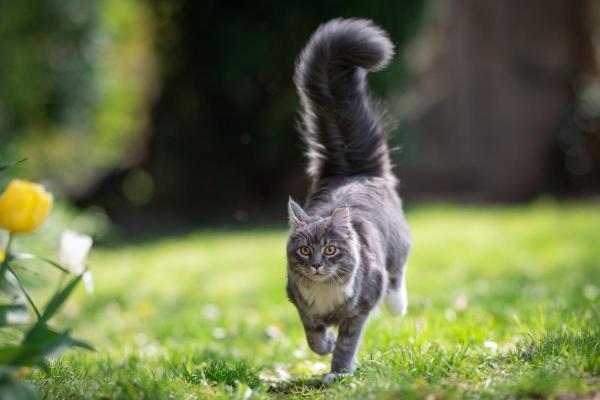
Discomfort
While tail vibration in cats is often a positive sign, this is not always the case. It may be that the cat feels slightly uncomfortable or annoyed by something in their environment. When a cat is shaking their tail like a rattlesnake, it may be they are providing a similar warning to their reptilian counterpart. When this is the case, we often observe the following:
- Tail vibrant constantly while moving back and forth
- Eyes wide open with dilated pupils
- Ears drooping or to the side
- Tense body posture
Understanding the reason why a cat is vibrating their tail requires looking at the context. While the above signs can signal agitation, it is also possible they manifest a feeling of uncertainty. When a cat feels insecure and can't quite identify how to respond to a certain stimuli, they may vibrate their tail as a response. In this context, the tail is usually curled at the top, but it may alternate between states of vibration or flicking.
To better understand this context, take a look at our article on what a cat's tail is trying to say to you.
What to do if a cat feels uncomfortable
The best way to stop a cat feeling uncomfortable is to find the cause of their discomfort. Sometimes this answer is obvious. For example, we may have introduced a new cat into the home or there might be something making a loud noise. Sometimes the reason for their discomfort is difficult to determine. Getting to know our cat's personality will go a long way in helping us to understand why they may be uncomfortable in a given situation.
Various stimuli in their environment can make a cat feel uncomfortable, but it is vital we are self-reflective. We need to analyze our own actions. For example, we may think the cat wants to be petted, but they are actually signaling they want to be left alone. It may mean we need to give the cat some space and let them dictate interactions.
Learn more about what a cat may be uncomfortable with our guide sharing the reasons why your cat is stressed.
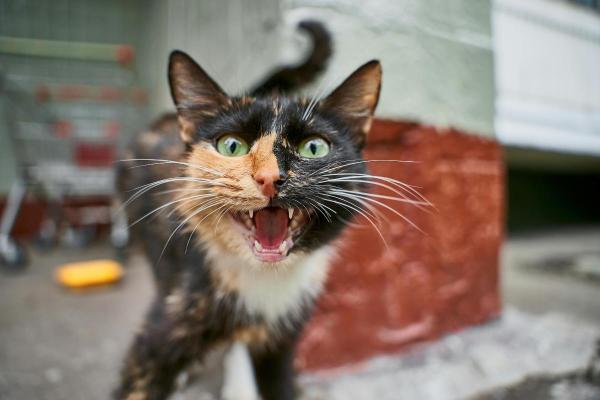
Fear
Fear in cats can manifest in various ways. Some may be outright aggressive, but others may try to maintain composure. This is because they fear action might result in a negative experience. Even when they try to hold it together, a cat may give themselves away by vibrating their tail when they feel threatened. Eventually, they will adopt a defensive posture, something characterized by the following signs:
- Bristled or vibrating tail
- Arched back
- Ears set back on head or flattened laterally
- Mouth open
- Dilated pupils
- Increased vocalizations
The vocalizations they carry out are mainly low-pitched meows, hisses and growls. Regarding the position of the tail, it should be noted that a frightened or fearful cat may carry their tail low, completely erect or in a so-called ‘horseshoe’ position, depending on the circumstances. The latter position is when the tail is hooked over on itself in the shape of a horseshoe.
What to do if a cat is scared
If you think a cat is afraid, observe their overall body language, not just their tail. It's also key to pay attention to the cat's environment and routine to identify which stimuli may be generating negative emotions such as fear.
Since we know this is not an easy task, you can use our guide to why a cat is scared of everything to help understand the context of this behavior.
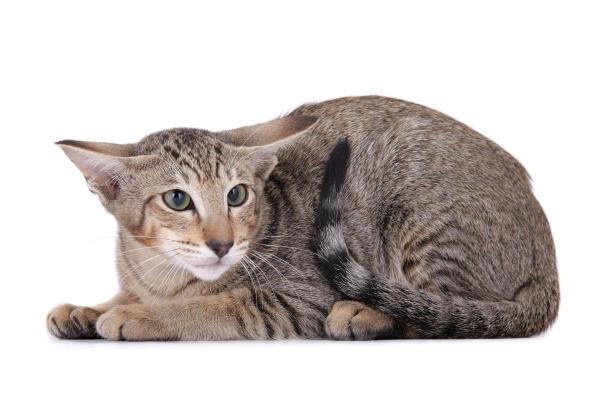
Anger
A cat vibrating their tail can sometimes be a clear sign of anger. This is because this movement will be accompanied by other signs. If a cat's fur is bristling and their tail is vibrating, they may be so angry they are preparing to attack. This offensive posture is often preceded by various signs of discomfort, fear or stress. In other words, it is rare for a cat to attack out of the blue or suddenly become aggressive.
When a cat is being aggressive, it is most often the case that we did not heed their warning signs. As we have explained, a vibrating tail is only one of the feline body language signals that show a cat is uncomfortable or afraid. If this signal is consistently ignored, the cat will feel they have no other opportunity but to become aggressive. Cats will not be aggressive for no reason, although it is not always easy to determine this cause.
In these contexts, an angry cat preparing to attack often displays the following physical signs:
- Completely tense body
- Hair standing on end
- Fixed gaze
- Well-constricted pupils
- Ears standing erect
- Piercing meows with growls and hissing
What to do if a cat is angry
If their tail is vibrating and you recognize one or more of the signs listed above, your priority should be to calm the cat down. It's best to avoid any type of interaction, as this could trigger an attack. Leave them alone until they feel safe and can calm down on their own. Once they have regained a minimum level of balance, you can assess what measures to take to prevent it from happening again.
In this sense, it's key to keep in mind that aggression is a behavioral problem with multiple causes. These include stress, poor socialization and even various physical health problems. If you notice your cat's behavior has suddenly changed, it's essential you consult a veterinarian to first rule out any pathological causes. If a physical cause has been discounted, you may need to speak to a feline ethologist to help determine the reason for their aggression.
You can learn more about what a cat's tail is trying to tell you with our article on why a cat wags their tail while lying down.
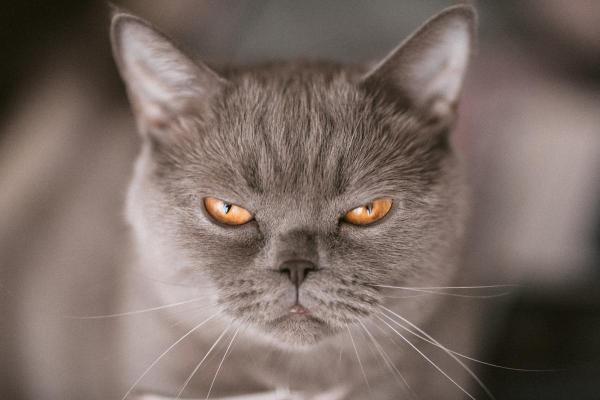
If you want to read similar articles to My Cat Is Vibrating Their Tail, we recommend you visit our Basic care category.









